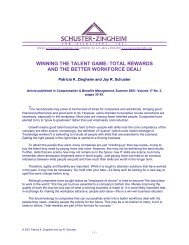competencies and competency models - Schuster-Zingheim and ...
competencies and competency models - Schuster-Zingheim and ...
competencies and competency models - Schuster-Zingheim and ...
Create successful ePaper yourself
Turn your PDF publications into a flip-book with our unique Google optimized e-Paper software.
To be sure, some frequently rewarded <strong>competencies</strong> are not prominent on the list of visionary<br />
principles (e.g., communication <strong>and</strong> team orientation). However, these are reasonably viewed as skills<br />
needed to realize other principles. It is also interesting that individual initiative, which is very often<br />
emphasized in the companies in Built to Last, is present only in the form of leadership in the list of<br />
rewarded <strong>competencies</strong>. The authors wonder if this <strong>competency</strong> is being underemphasized currently.<br />
The authors are struck by the similarity in the lists of <strong>competencies</strong> rewarded in <strong>competency</strong>-based<br />
pay plans used by different companies. If companies are attempting to gain competitive advantage by<br />
rewarding <strong>competencies</strong> that are closely related to their business needs, why is this happening?<br />
There are a number of possible explanations. For instance, organizations may be studying what<br />
makes for great companies. They may be looking more closely at premier companies such as those<br />
described in Built to Last, or they may be going through their own self-discovery processes. Further<br />
explanations of why similar <strong>competencies</strong> are being used include the following:<br />
• Organizations share environmental challenges. Perhaps companies share common business<br />
environments that dictate common solutions. This means they have diagnosed their competitive<br />
environment <strong>and</strong> have concluded that shared problems deserve shared solutions. This suggests<br />
that environmental challenges are generic <strong>and</strong> global.<br />
• Organizations share common shortcomings. It is possible that companies determine they fall<br />
short on a number of similar capabilities they believe are critical to success. For example, they<br />
may have an incomplete emphasis on customer care, ineffective communication or the inability to<br />
collaborate well. This would support a concept of not only shared challenges but also shared<br />
shortcomings.<br />
• Organizations seek advantage through execution. Although many companies share business<br />
strategies—<strong>and</strong>, apparently, <strong>competency</strong> strategies as well—they may be seeking unique<br />
advantage through better execution. This would mean that organizations select the <strong>competencies</strong><br />
that best communicate their business strategies, <strong>and</strong> they count on implementation to achieve an<br />
advantage. This would suggest that wherever <strong>competencies</strong> come from, <strong>and</strong> regardless of which<br />
<strong>competencies</strong> are deployed, execution is the key.<br />
• Organizations have discovered the "ultimate" <strong>competency</strong> model. Reviewing the companies cited<br />
by Collins <strong>and</strong> Porras <strong>and</strong> the 10 companies in the authors' overview sample, perhaps a<br />
"universal" <strong>competency</strong> model <strong>and</strong> associated battery of <strong>competencies</strong> exist. Pay professionals<br />
will recall that the days of point-factor job evaluation resulted in the "discovery" of several<br />
"ultimate" job-evaluation factors. The same situation could exist for <strong>competencies</strong>. If this is the<br />
case, organizations need only select from a limited list of <strong>competencies</strong>.<br />
• Selection of <strong>competencies</strong> is common sense. It is possible that organizations are choosing<br />
<strong>competencies</strong> as a matter of common sense after reviewing available alternatives. Companies<br />
could arrive at the most common <strong>competencies</strong> in the authors' study—communication, concern<br />
for customers, improved technical expertise, more effective innovation <strong>and</strong> so forth—based on an<br />
underst<strong>and</strong>ing of what makes sense relative to the values, behaviors <strong>and</strong> skills that are required<br />
for organizational success. Clearly, business literature is ripe with advocates for these widely<br />
shared principles.<br />
• Organizations prefer to copy <strong>competencies</strong> from successful role <strong>models</strong>. Walt Disney Co., AT&T,<br />
IBM Corp., Motorola <strong>and</strong> others are popular role <strong>models</strong> for many practices, including those for<br />
human resources. It is possible these exemplary firms serve as examples for <strong>competencies</strong> even<br />
though they may not deploy <strong>competencies</strong> or <strong>competency</strong>-based pay. For example, performance<br />
goals <strong>and</strong> initiatives in such areas as communication, customer service <strong>and</strong> results orientation<br />
© 1996 Patricia K. <strong>Zingheim</strong>, Gerald L. Ledford Jr. <strong>and</strong> Jay R. <strong>Schuster</strong><br />
- 4 -



